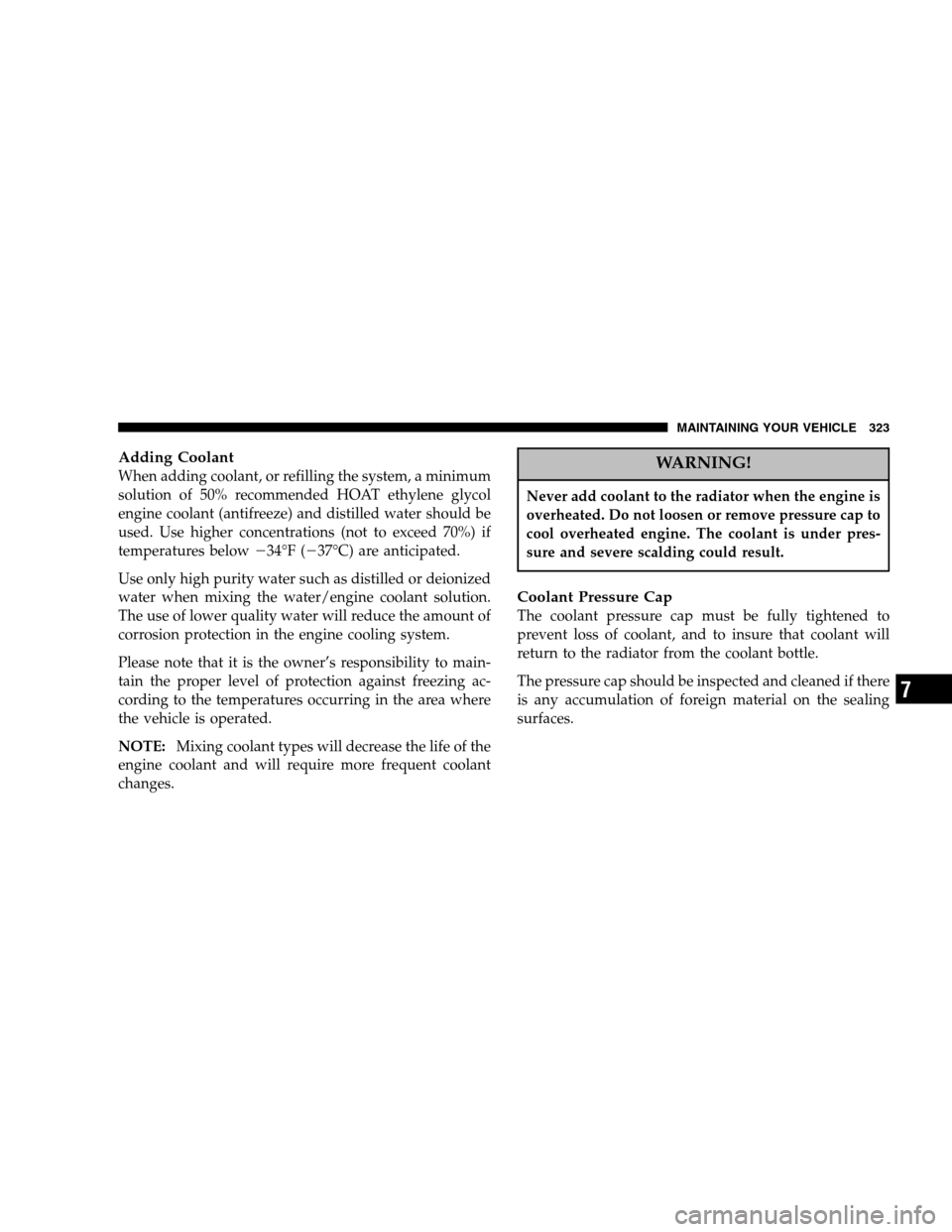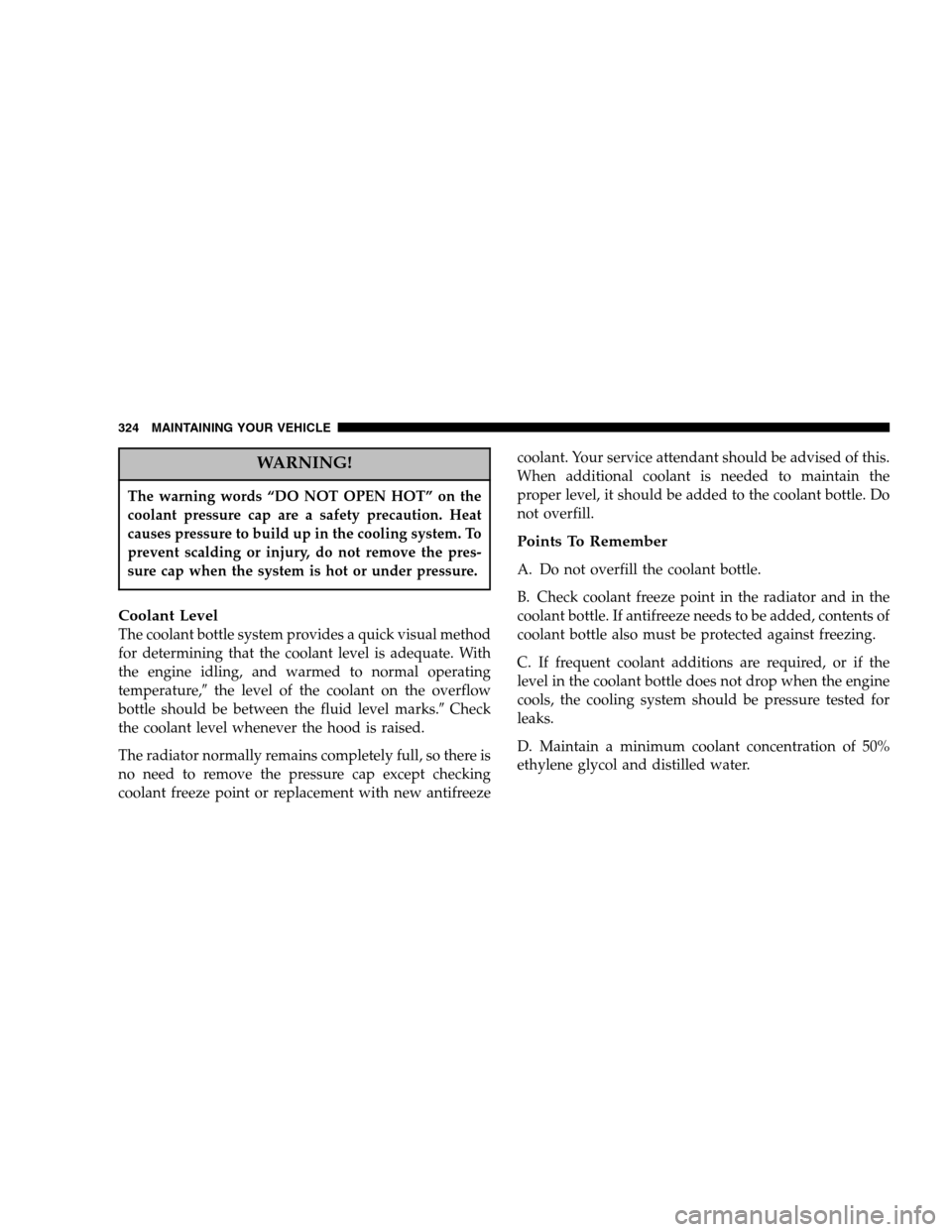Page 321 of 408

Check the coolant bottle tubing for condition and tight-
ness of connection at coolant bottle and radiator. Inspect
the entire system for leaks.
WARNING!
You or others can be badly burned by hot coolant or
steam from your radiator. If you see or hear steam
coming from under the hood don’t open the hood
until the radiator has had time to cool. If you open
the hood and see steam or hot coolant escaping from
the radiator, don’t touch anything. Get away quickly.
Never try to open a pressure cap when the radiator is
hot.
Cooling System Maintenance
At the intervals shown in the Maintenance Schedules
section of this manual, the system should be drained,
flushed and refilled. See your authorized dealer for
proper cooling system maintenance.
Cooling System — Drain, Flush And Refill
If the solution is dirty and contains a considerable
amount of sediment, it should be cleaned and flushed.
See your authorized dealer for proper draining, flushing
and refilling of your vehicle’s cooling system.
Disposal of Used Engine Coolant
Used ethylene glycol based engine coolant is a regulated
substance requiring proper disposal. Check with your
local authorities to determine the disposal rules for your
community. Do not store ethylene glycol based engine
coolant in open containers or allow it to remain in
puddles on the ground. Prevent ingestion by animals and
MAINTAINING YOUR VEHICLE 321
7
Page 322 of 408

children. If ingested, contact a physician or poison con-
trol specialist in your area. Clean up any ground spills
immediately.
Recommended Engine Coolant
This vehicle has been factory filled with an Ethylene
Glycol based engine coolant with long life corrosion
inhibitors (called HOAT, for Hybrid Organic Additive
Technology). Follow the “Maintenance Schedule” for the
recommended coolant change intervals. Refer to Fluids,
Lubricants and Genuine Parts for correct fluid type.
CAUTION!
Mixing of coolants other than specified (non-
HOAT), may result in engine damage and decreased
corrosion protection. If a non-HOAT coolant is intro-
duced into the cooling system in an emergency, it
should be replaced with the specified coolant as
soon as possible.
Do not use plain water alone or alcohol base anti-
freeze products. Do not use additional rust inhibi-
tors or antirust products, as they may not be compat-
ible with the radiator coolant and may plug the
radiator.
This vehicle has not been designed for use with
Propylene Glycol based coolants. Use of Propylene
Glycol based coolants is not recommended.
322 MAINTAINING YOUR VEHICLE
Page 323 of 408

Adding Coolant
When adding coolant, or refilling the system, a minimum
solution of 50% recommended HOAT ethylene glycol
engine coolant (antifreeze) and distilled water should be
used. Use higher concentrations (not to exceed 70%) if
temperatures below �34°F (�37°C) are anticipated.
Use only high purity water such as distilled or deionized
water when mixing the water/engine coolant solution.
The use of lower quality water will reduce the amount of
corrosion protection in the engine cooling system.
Please note that it is the owner’s responsibility to main-
tain the proper level of protection against freezing ac-
cording to the temperatures occurring in the area where
the vehicle is operated.
NOTE: Mixing coolant types will decrease the life of the
engine coolant and will require more frequent coolant
changes.WARNING!
Never add coolant to the radiator when the engine is
overheated. Do not loosen or remove pressure cap to
cool overheated engine. The coolant is under pres-
sure and severe scalding could result.
Coolant Pressure Cap
The coolant pressure cap must be fully tightened to
prevent loss of coolant, and to insure that coolant will
return to the radiator from the coolant bottle.
The pressure cap should be inspected and cleaned if there
is any accumulation of foreign material on the sealing
surfaces.
MAINTAINING YOUR VEHICLE 323
7
Page 324 of 408

WARNING!
The warning words “DO NOT OPEN HOT” on the
coolant pressure cap are a safety precaution. Heat
causes pressure to build up in the cooling system. To
prevent scalding or injury, do not remove the pres-
sure cap when the system is hot or under pressure.
Coolant Level
The coolant bottle system provides a quick visual method
for determining that the coolant level is adequate. With
the engine idling, and warmed to normal operating
temperature, �the level of the coolant on the overflow
bottle should be between the fluid level marks. �Check
the coolant level whenever the hood is raised.
The radiator normally remains completely full, so there is
no need to remove the pressure cap except checking
coolant freeze point or replacement with new antifreeze coolant. Your service attendant should be advised of this.
When additional coolant is needed to maintain the
proper level, it should be added to the coolant bottle. Do
not overfill.
Points To Remember
A. Do not overfill the coolant bottle.
B. Check coolant freeze point in the radiator and in the
coolant bottle. If antifreeze needs to be added, contents of
coolant bottle also must be protected against freezing.
C. If frequent coolant additions are required, or if the
level in the coolant bottle does not drop when the engine
cools, the cooling system should be pressure tested for
leaks.
D. Maintain a minimum coolant concentration of 50%
ethylene glycol and distilled water.
324 MAINTAINING YOUR VEHICLE
Page 355 of 408
FLUIDS AND CAPACITIES
U.S. Metric
Fuel 3.7L/4.7L, 87 Octane 22 Gal. 83L
4.7L HO, 91 Octane, Recommended Not Required 22 Gal 83L
Engine Oil (with filter) 3.7L, SAE 5W-30, API Certified 5 Qt. 4.7L
4.7L, SAE 5W-30, API Certified 6 Qt. 5.7L
4.7L HO, SAE 5W-30, API Certified 6 Qt. 5.7L
Cooling System (includes 2.1 Qts./2L for coolant bottle 3.7L (Mopar � Antifreeze/Coolant 5 Year/100,000 Mile Formula) 13.3 Qt. 12.5L
4.7L (Mopar � Antifreeze/Coolant 5 Year/100,000 Mile Formula) 13.3 Qt. 12.5L
4.7L HO (Mopar � Antifreeze/Coolant 5 Year/100,000 Mile Formula) 13.3 Qt. 12.5L
NOTE: All fluid capacities are approximate capacities.
MAINTAINING YOUR VEHICLE 355
7
Page 356 of 408
FLUIDS, LUBRICANTS AND GENUINE PARTS
Engine
Component Fluids, Lubricants and Genuine Parts
Engine Coolant Mopar �Antifreeze/Coolant 5 Year/100,000 Mile Formula HOAT (Hybrid Or-
ganic Additive Technology) or equivalent.
Engine Oil Use SAE 5W-30, API Certified, meeting material standard MS-6395.
Engine Oil Filter Mopar �Engine Oil Filter, P/N 5281090 or equivalent.
Spark Plugs Refer to the Vehicle Emission Control Information label in the engine com- partment.
Fuel Selection 3.7L/4.7L 87 Octane, (R+M)/2 Method
Fuel Selection 4.7L HO 91 Octane, (R+M)/2 Method (Recommend, Not Required.)
356 MAINTAINING YOUR VEHICLE
Page 361 of 408

MAINTENANCE SCHEDULES
There are two maintenance schedules that show the
required service for your vehicle.
First is Schedule “B”. It is for vehicles that are operated
under the conditions that are listed below and at the
beginning of the schedule.
•Day or night temperatures are below 32° F (0° C).
•Stop and go driving.
•Extensive engine idling.
•Driving in dusty conditions.
•Short trips of less than 10 miles (16 km).
•More than 50% of your driving is at sustained high
speeds during hot weather, above 90° F (32° C).
•Trailer towing.
•Taxi, police, or delivery service (commercial service).
•Off-road or desert operation.
•Heavy Loading
•If equipped for and operating with E-85 (ethanol)
fuel.
NOTE: IfANY of these apply to you then change your
engine oil every 3,000 miles (5 000 km) or 3 months,
whichever comes first and follow schedule “B” of the
� Maintenance Schedules �section of this manual.
NOTE: IfANY of these apply to you then change your
coolant every 102,000 miles (170 000 km) or 60 months,
whichever comes first and follow schedule “B” of the
� Maintenance Schedules �section of this manual.
Second is Schedule “A”. It is for vehicles that are not
operated under any of the conditions listed under Sched-
ule �B�.
MAINTENANCE SCHEDULES 361
8
M
A I
N T
E
N A
N C E
S
C
H E
D
U L
E
S
Page 363 of 408
Once a Month
•Check tire pressure and look for unusual wear or
damage.
•Inspect the battery and clean and tighten the terminals
as required.
•Check the fluid levels of coolant reservoir, brake
master cylinder, and transmission and add as needed.
•Check all lights and all other electrical items for correct
operation. At Each Oil Change
•Change the engine oil filter.
•Inspect the exhaust system.
•Inspect the brake hoses.
•Inspect the CV joints (if equipped) and front suspen-
sion components.
•Check the automatic transmission fluid level (if
equipped).
•Check the manual transmission fluid level (if
equipped).
•Check the coolant level, hoses, and clamps.
MAINTENANCE SCHEDULES 363
8
M
A I
N T
E
N A
N C E
S
C
H E
D
U L
E
S